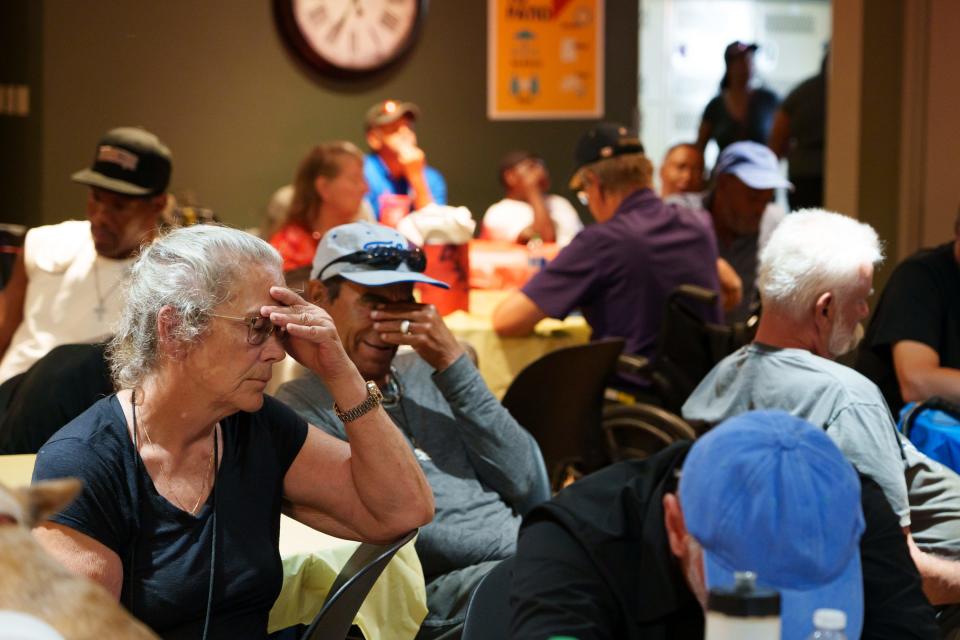Phoenix's heat is killing homeless people. Here's why their deaths are so hard to prevent
The relentless heat in metro Phoenix exacts its heaviest toll on the least-resourced people.
There’s no greater nexus than that between heat-associated deaths and homeless and poor people.
Maricopa County is in the midst of a perfect storm: A convergence of more intense high temperatures and more folks living on the streets or on the verge of it.
The consequence is a the record number of heat-associated deaths since the start of the pandemic.
Phoenix's heat-related deaths are surging
In 2019 and earlier, the tally of deaths never rose above 200. In 2020 and 2021, the number topped 320.
Last year 425 people died in some way related to heat, about 42% of whom were homeless. (In another 25% of the cases, there were difficulties establishing the person’s living situation.)
This year is shaping up to be just as bad.
It may be alarmist to say this trend could be the new normal. Or that unless Mother Nature moderates, things may get even worse.
But no more striking than headlines about Maricopa County bringing in coolers late last month to store bodies as the morgue exceeded capacity.
Or that the county may expand capacity on a permanent basis, which is a plausibility.
Chief Medical Examiner Dr. Jeff Johnston noted that in 2019, his office ramped up to 120 bodies a week in July. That number surged to 180 this July.
Cooling stations have expanded their work

The heat-associated death tally isn’t necessarily an indictment of the efforts of those working in public health or providing homeless services.
Rather, it’s reflective of the bedeviling challenge that is stopping preventable deaths among the most vulnerable.
Maricopa County started tracking heat-associated deaths — those caused by heat or in which heat played a role — in 2006 after a prolonged heat wave the summer before.
Some three dozen people died within a 9-day span of a heat wave.
Remembering a father: One of dozens who died during heat wave
Over the years, in tandem with the city of Phoenix as part of the Heat Relief Network, Maricopa Association of Governments established cooling centers where vulnerable people can wander in for water, snacks and respite from the summer heat.
The facilities — many of them community, senior and religious centers that already provide services — now number more than 100, about double from a decade ago. They’ve grown to operating longer hours and on the weekends.
More homeless, addicted people are dying
Some patterns on heat-associated deaths have stayed unsurprisingly constant:
An overwhelming majority of those who died were 50 and older. Heat exacerbates health problems and conditions that younger people can better withstand.
A similar majority, about 2 out of 3, had no schooling beyond high school. Health officials use education background as a surrogate marker for income.
A number of those who died and had housing either did not have an air-conditioning unit that worked or had operable A/C but did not turn it on or had no electricity. (The county earmarked $3.6 million in pandemic funds this year to help residents fix their air-conditioning and ventilation systems.)
More telling are trends of recent years:
Deaths involving homeless individuals have jumped 20 percentage points or more in the last three years from preceding years.
Deaths involving homeless individuals who were on drugs spiked by similar margins.
How do we help those who are on meth?
On the former, there’s been stepped-up urgency.
Phoenix has directed tens of millions of dollars in federal aid the past couple of years to expand both overnight shelter space and longer-term housing.
The county itself distributed millions of dollars in aid, including hundreds of thousands to cities like Chandler/Mesa, Glendale and Phoenix for street outreach, shower trailers, transportation to heat relief centers and the like.
The drug-use segment is a harder nut to crack.
Notable is the impact of methamphetamine, which was a primary cause of most heat-associated deaths involving homeless people. The drug puts the body in overdrive, reduces its ability to cool down and especially taxes the heart and the kidneys.
Meth, in fact, contributed to more than half of all 425 heat-associated deaths in 2022, regardless of whether the person was homeless or not.
Sadly, we may need to help others first
There’s widespread agreement that unsheltered people with substance abuse are the toughest ones to persuade to enter shelters or, more importantly, into treatment programs.
Addicts themselves would admit they won’t seek help when they’re in the throes of their altered states — or desperately seeking to get there.
They’re the ones dying at the highest rates.
Nonetheless, making them the highest priority is neither easy nor sensible.
Not when hundreds of people are still living in “The Zone“ in central Phoenix even as authorities clear the sprawling encampment, block by block, to steer them out of the heat into shelters and services.
Many of them presumably are more ready and receptive to receive help.
Short of a drastic pivot toward jailing them if they don’t enter treatment, unsheltered substance abusers will continue to succumb to the Valley’s brutal heat.
Reach Abe Kwok at akwok@azcentral.com. On X, formerly Twitter: @abekwok.
This article originally appeared on Arizona Republic: Heat kills homeless people. Why their deaths are so hard to prevent
